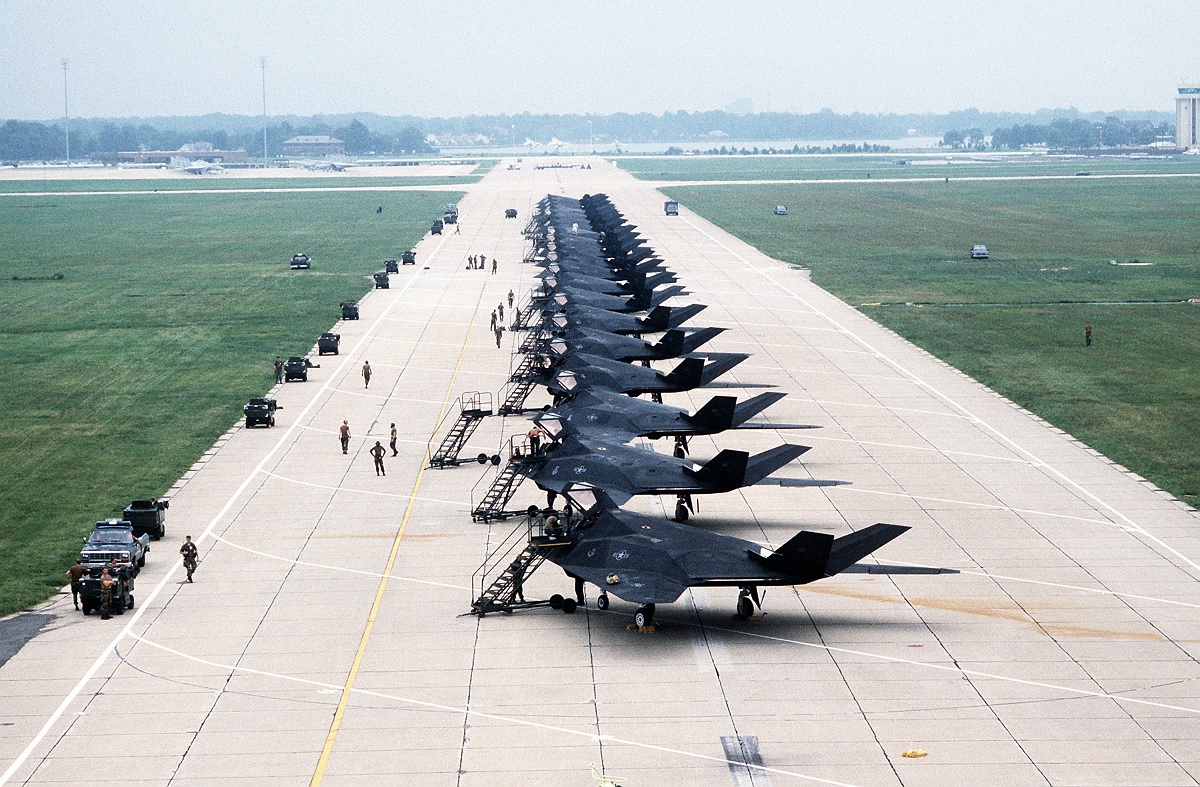The F-117 lighted the bunker’s entrance and directed two Paveway II LGBs, each weighing 2,000 pounds, toward the intended target. The first one destroyed the door, and the second one entered and destroyed the bunker. Once more, the F-117 pilot struck his intended target square on
The Lockheed F-117 was created in response to a request from the U.S. Air Force (USAF) for an aircraft that could attack valuable targets without being seen by adversarial radar. By the 1970s, engineers were able to create an airplane with radar-avoiding or “stealth” characteristics because of new materials and methods. The F-117A, the first operational stealth aircraft in the world, was the outcome.
On June 18, 1981, the first F-117A took to the skies, and on October 1, 1983, the 4450th Tactical Group—later renamed the 37th Tactical Fighter Wing—attained initial operational capability. On December 19, 1989, two F-117As from the 37th TFW bombed military targets in Panama as part of Operation Just Cause.

The 415th and 416th squadrons of the 37th TFW relocated to a base in Saudi Arabia for Operation Desert Shield/Storm in 1990-1991, and the F-117 saw action once more during that conflict.
Operation Desert Shield changed its name to Operation Desert Storm on January 16, 1991, and the biggest aerial bombardment in the annals of contemporary warfare followed. Over 1,000 sorties were carried out on the first night of bombing against targets in Iraq and Kuwait. That is equivalent to every sortie flown during D-Day of Normandy.
The F-117As of the 37th TFW were the first manned USAF aircraft to enter hostile Iraqi airspace, as described by Jim Goodall in his book F-117 Stealth In Action. “At approximately 0130 on 17 January, two squadrons of F-117As dropped approximately sixty 2,000 pound bombs on key Iraqi air defense, command and control facilities, ammunition bunkers, SCUD surface-to-surface missile bunkers, missile storage facilities, and the headquarters of the Iraqi Air Force,” he explains.

On January 20, 1991, Gen. Schwarzkopf, the commander of American and Allied forces in the Gulf, showed a media outlet an infrared film of F-117A striking important targets in Iraq. “One of the key targets that showed the capability of the F-117A was a view of a SCUD storage facility that had three air ducts on its roof, each approximately a meter in diameter. The main air duct was identified by the F-117A pilot and the laser cursor was locked on the center of the air duct. A 2,000-pound laser-guided bomb was released and entered the bunker through the air duct. The SCUD storage bunker was totally destroyed in a spectacular explosion,” explains Goodall.
An attack on an ammo bunker close to Baghdad was another noteworthy incident that was featured on CNN and other major television networks. “The F-117A illuminated the front door of the bunker and guided two 2,000-pound Paveway II LGBs into the target. The first blew down the door; the second one went inside and blew up the bunker. Again the F-117A pilot hit his target dead center,” says Goodall.
The most impressive attack, according to Gen. Kelly, Commander of Air Force Operations in Desert Storm, was made against “My counterpart’s headquarters in downtown Baghdad.” The video depicted a rectangular, ten-story structure. An elevator shaft was located in the middle of the roof. An F-117A flew straight above the structure, locking its laser on the elevator shaft and firing a BLU-109 deep penetration weapon. The bomb has a delayed-action fuse and a reinforced steel shell that can pierce up to six feet of concrete. It appeared to go some distance inside the structure before exploding after falling through the top of the elevator shaft. The building’s four walls were visible being blasted outward in the footage.
According to Col. Al Whitley, the F-117As flew 1,271 missions during the conflict, or around one percent of the 110,000 missions flown by the Allied Air Forces, with an 80% success rate. The F-117As were the only aircraft used in assaults on heavily fortified targets in and around Baghdad on the first night of the war, accounting for 31% of all targets struck during the first twenty-four hours of the conflict.
The first bomb of the conflict was dropped by an F-117A, which was hitting a communications hub in Baghdad.

On the night of Jan. 16, 1991 “the F-117A proved beyond the shadow of a doubt that Ben Rich, of Lockheed’s Advanced Development Projects, and this team of dedicated aerospace workers had built the most capable surgical strike aircraft in the story of modern warfare,” Goodall concludes.
The following video, which includes some clips of the F-117A raid on the Baghdad communications center, was shot on the first night of Operation Desert Storm.
Photo by U.S. Air Force

